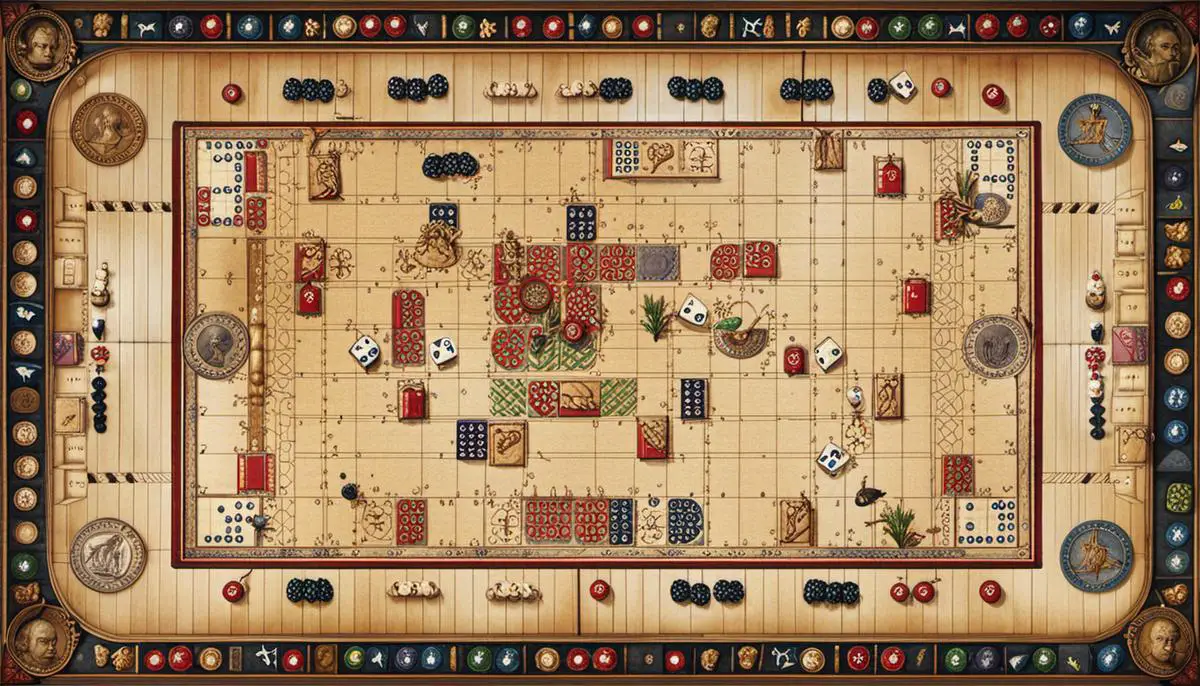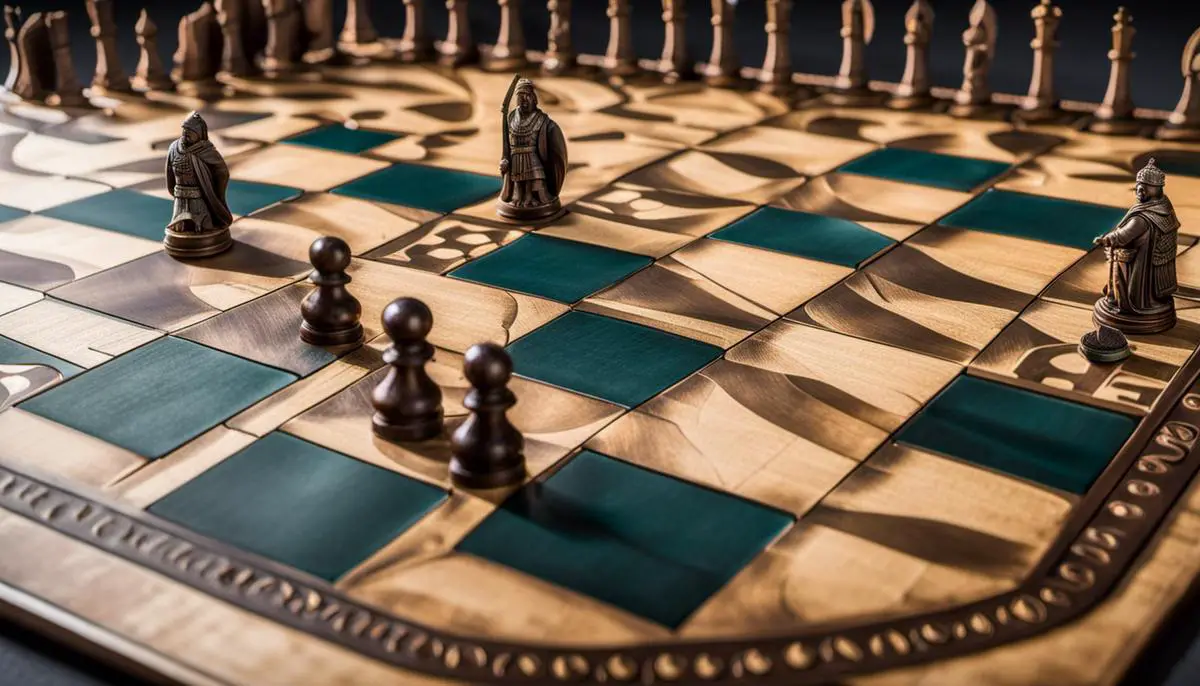Take a journey back in time, to an era replete with gladiators, aqueducts, and emperors – the vibrant and engrossing world of ancient Rome. While amphitheaters and legions often dominate the imagery, the Roman era was also rich in more subtle forms of entertainment, specifically board games. These games, often played in social settings and military encampments, offered a glimpse into the strategic thinking and recreational pastimes of the Romans. Spanning from complex games like Ludus Latrunculorum that required elaborate strategy, to intuitive ones like Terni Lapilli, reminiscent of our modern-day Tic-Tac-Toe, these games provided more than just amusement, they framed societal interactions and reflections of fate.
Ludus Latrunculorum
Popular amongst the Romans: Ludus Latrunculorum
Often referred to as the ‘game of mercenaries’, Ludus Latrunculorum was a crowd favorite in ancient Rome. The board game, played on a simple grid layout, was much more strategic than it initially appeared. Its main objective was to get ahead of the opponent by capturing their pieces, a concept that might bring to mind modern games like Chess or Checkers.
Strategy and Tactics Galore
A considerably complex game, Ludus Latrunculorum wasn’t just about grabbing your opponent’s pieces. It required planning, tactical maneuvers and strategies. In essence, players had to outwit their opponents by trapping their pieces, leading to their eventual capture.
A Military Pastime: Refreshing or Draining?
Although a board game, Ludus Latrunculorum had a strong abduction theme that contributed to its appeal amongst the military. It’s believed that the game was played extensively in Roman military camps, serving as both a source of entertainment and a means for intellectual stimulation.
An Unseen Educational Role
Even as the soldiers trained their bodies for wars, Ludus Latrunculorum helped in developing their strategic thinking abilities. It’s highly probable that many a Roman warrior honed their battle planning skills over many rounds of this board game, translating theoretical strategies into practical victories.
Unresolved Mystery: The Complete Rules
While fascinating, Ludus Latrunculorum comes to us shrouded in mystery. Across centuries, understanding the game’s complete rules and specifics has proven to be a challenge. Despite substantial information about its existence and popularity, the detailed rules of play remain a subject of speculation. This only adds to its appeal, making it not just a game from the past, but also a puzzle from history begging to be solved.

Duodecim Scriptorum
Roman Entertainment: Duodecim Scriptorum
Often considered the forerunner to the modern game of Backgammon, Duodecim Scriptorum was a popular pastime in the Roman era. Translated as ‘game of twelve lines,’ this board game was widely played and enjoyment was derived from both its gaming strategy and the symbolism that was often associated with it.
Duodecim Scriptorum: The Design
The game board for Duodecim Scriptorum was comprised of 36 squares, organized into three rows of twelve squares each. This simplistic yet effective design allowed for easy portability, adaptable gameplay, and strategic planning. The layout likely influenced the eventual design of the Backgammon board, which also includes rows and multiple pockets or divisions.
Gameplay: A Mix of Strategy and Chance
Despite its seemingly straightforward design, Duodecim Scriptorum was a game that merged calculated strategy with elements of chance. Gameplay involved three dice, which players would throw to determine the movement of their pieces on the board. This element of unpredictability added an extra thrill to the game and kept players engaged, as they attempted to outwit fate – and each other – in order to win.
Duodecim Scriptorum: Beyond Just a Game
Interestingly, Duodecim Scriptorum was not just seen as a recreational activity. Intricately tied to beliefs of the era, the game was also perceived as a representation of fate and chance. The unpredictable outcome of the dice rolls and the resulting game movements effectively echoed the uncertainties of real life. Playing Duodecim Scriptorum, therefore, was not just about winning, but also about experiencing and interpreting this metaphor for existence. Over time, this multi-dimensional game developed a significant cultural and societal value, indicating the depth of its impact on the Roman era.

Terni Lapilli
The Historical Game of Terni Lapilli
Terni Lapilli, often translated to ‘three pebbles at a time’, was a popular board game during the Roman Era that shares striking similarities with the concept of modern Tic-Tac-Toe. The game’s board was typically divided into nine compartments, just as we see in the contemporary version. Players would take turns to place markers, in the form of either pebbles, coins, or possibly colored stones, aiming to align three markers in a horizontal, vertical, or diagonal pattern before their opponent could do the same.
The Rules and Gameplay
The game is speculated to have begun with an empty board where two players would alternately place three pieces on the board until one would achieve a sequence of three. Upon the unlikely event of a draw, they would have possibly continued laying down pieces alternatively. The game would continue until one player had a trio aligned. Much like how we play Tic-Tac-Toe today, the key was to block your opponent’s chances of creating a complete line before they could do the same to you.
The Cultural Significance
This board game was more than just a way to pass time. It was an evident and widespread part of Roman culture. The uniqueness of the game lies in the nonexistence of any physical game boards. Instead, people would etch the design into building floors made of limestone, stone slabs, or slate, or even tables. This act says volumes about the game’s popularity, suggesting that Roman citizens wanted the game to be available to play at a moment’s notice. Terni Lapilli, while simple in design, was a beloved pastime and a reflection of Roman social dynamics.

Whether it was the strategic depth of Ludus Latrunculorum, the chance-based competition of Duodecim Scriptorum, or the straightforward charm of Terni Lapilli, each of these games articulated the diverse ways Romans sought fulfillment and diversion in their recreational pursuits. Fascinatingly, these ancient pastimes continue to live on through their modern counterparts, reminding us that in every era, the human thirst for challenge, engagement, and entertainment persists. So the next time you find yourself engrossed in a game of chess or tic-tac-toe, remember that you’re taking part in a tradition that dates back centuries, to the grand days of the Roman Empire itself.
Frequently Asked Questions: Roman-Era Board Games
A: Ancient Romans enjoyed a variety of board games, including Ludus Latrunculorum, Tabula, and Duodecim Scripta, which offered diverse gameplay experiences.
A: Ludus Latrunculorum, also known as Latrunculi, was a strategic two-player game where opponents moved their pieces on a grid to capture and eliminate their opponent’s pieces.
A: Tabula, a precursor to modern Backgammon, was a race game played with dice and pieces moved along a track. It involved strategy, tactics, and luck.
A: Duodecim Scripta was a precursor to modern games like Backgammon and Parcheesi. Players moved pieces on a board using dice rolls to reach the goal first.
A: Yes, board games in ancient Rome held cultural significance and were not just a form of entertainment; they played a role in social gatherings and intellectual pursuits.
A: While some ancient Roman board games have evolved into modern games, others have been lost to history. However, some enthusiasts recreate and play these historical games today.
A: Ancient Roman board games were crafted from various materials such as wood, stone, or clay, showcasing the craftsmanship and ingenuity of the time.
A: Yes, board games were enjoyed by people from various social classes in ancient Rome. They were a popular form of entertainment for both commoners and the elite.
A: Yes, archaeological discoveries have unearthed ancient Roman game boards and pieces, many of which are displayed in museums, providing valuable insights into the past.
A: To experience ancient Roman board games, you can explore historical recreations, visit museums, or try modern versions inspired by the games enjoyed by the Romans.
A: Yes, there are historical and archaeological books, as well as online resources, that delve into the history and gameplay of ancient Roman board games.
